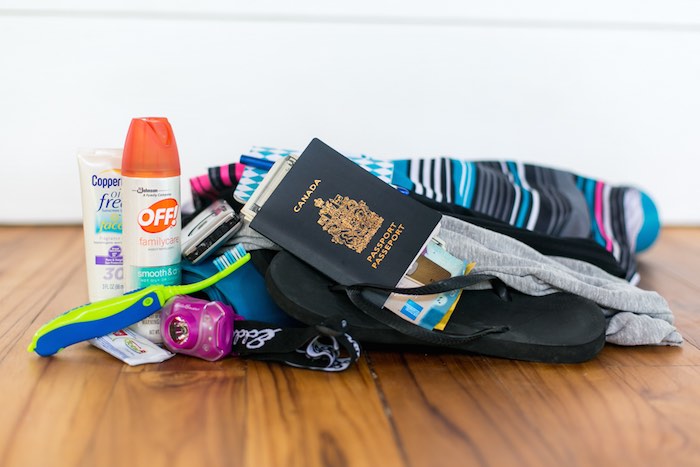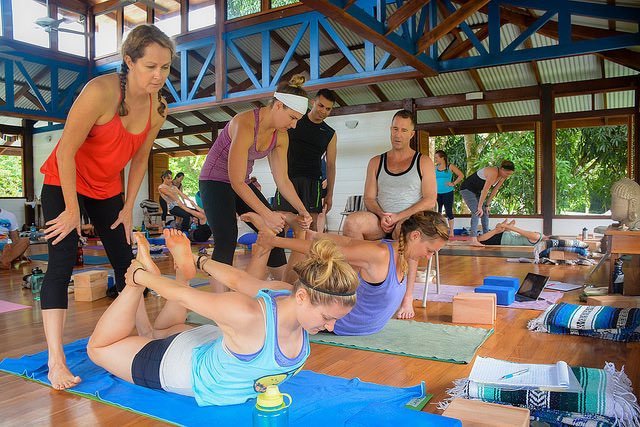Living in Costa Rica has allowed me to experience nature at its finest. I’m fortunate enough to be living in the Osa Peninsula of Costa Rica where the jungle meets the ocean. I’m working at a yoga resort and spa named Blue Osa. Every week, we receive a new yoga retreat group who each bring a new theme. No two weeks are the same. There’s a change of energy each time a group changes over. Some are focused on detoxing and practicing silence, and others love to take advantage of the wide array of wine and cocktails Blue Osa has to offer. They all seem to have one thing in common, though – they all wished they’d had a packing list to refer to.
What Should You Bring to Your Next Yoga Retreat in Costa Rica?
Advice from Someone Who Works at a Yoga Resort
Below is a list of suggestions for packing that you may find useful if you’re considering joining a yoga retreat in Costa Rica. The inspiration for this list comes from talking to our guests and from my own experience of living at a yoga resort. It’s specifically geared toward the tropical weather-loving beach bum yogi.
The Essential Packing List

- Yoga Mat.
Most yoga resorts provide their own mats for their guests. But, if you’re like me and love your own yoga mat then I recommend bringing your own.
- Yoga Towel.
I don’t go anywhere without mine! You never know what sequence your yoga teacher will teach that day. It could be a sweaty 90 minute one. Also, the heat of Costa Rica will naturally increase the temperature of your practice. There’s nothing more annoying than being in downward facing dog pose and battling with your hands not to slip because of your sweat. A yoga towel will prevent this!
- Bathing Suits.
If your resort has a pool or is near a beach, a bathing suit is a must. Even if you’re not a sunbathing lover, there’s always somewhere shady to enjoy the heat. Plus, after all, the yoga you’ll be doing, a dip in the ocean or pool is a fabulous way to cool off. I recommend bringing at least two so you can switch between them while the other one dries out.
- Yoga Clothing.
If this wasn’t obvious enough! Most people wonder what kind of clothing and this is where I can help you out.
◦ 5 light tops – some with built-in bras for the ladies.
◦ 5-6 shorts or light pants – the heat will mean you’ll want to wear as little as possible.
- Light PJ’s.
In the dry season, the heat can be felt at night time. After practicing hours of yoga, there’s nothing better than a good night’s rest. I like to sleep in a big shirt and my underwear. If you don’t feel comfortable wearing this, I recommend a very light shirt and shorts.
- Nice Clothing.
In most yoga resorts in Costa Rica, dinner time is a time to dress nicely and enjoy the food and company around you. Bring 3 to 4 casual but nice dresses. For men, 3 to 4 nice shirts and pants will be great.
- Casual Clothing.
After practicing yoga and before dinner time, you’ll want to be in casual, relaxing clothing.
- Passport.
You’ll need this to travel in and out of Costa Rica. Double check your passport’s expiration date.
- Wallet – Card/cash.
I recommend bringing both your credit card and cash. Some places only accept cash! If you want to tip, cash is appreciated.
- Flashlight.
A flashlight is mandatory when walking on the beach or around the property at night. There’s a lot of exotic and mysterious animals in this country. The last thing you want is to tread on one of Costa Rica’s less-understanding creatures!
- Sunscreen.
You’ll be soaking up lots of sun. It’s very important to protect yourself from sunburn. We don’t want your week to be spoilt by a burning back. Trust me, yoga isn’t as fun when you resemble a lobster! Be careful with your sun exposure, aim for no longer than 30 minutes. If you live in a cool climate and you’re not exposed to the sun much, it could be worth considering 15 minutes as optimum tanning time. Don’t forget your sunscreen – minimum factor 30.
- Insect Repellent.
This is a must. Depending on the time of year, mosquitos can be in abundance in Costa Rica. Bug spray will ward off these little critters.
- Umbrella
Don’t get caught in a rain storm! An umbrella can save you.
- Favourite book.
I love bringing a good book on my vacation. Remember this is a time for you to unwind and relax. Getting lost in one of your favorite books by the ocean, pool, or in bed can add that little extra to your week.
- Camera.
Whether it’s your first time or not to Costa Rica, there’s always something new to see. Sloths, flowers, sunrises, and so much more. You’ll be glad to have a means of capturing Costa Rica’s beauty.
- Shoes.
◦ Water Shoes. There’re many exertions on offer where water shoes will come in really handy. If you’re swimming in the ocean during low tide, you’ll be grateful for your water shoes. I’ve prevented many cuts on my toes thanks to my water shoes.
◦ Sandals. Regular sandals to get you through the day.
◦ Running Shoes. In case you want to take a walk or jog, or even go hiking. Active shoes are great.
- Water Bottle.
Sure, you can keep refilling a cup with water, but a water bottle enables you to keep water with you at all times in greater supply. Don’t forget the heat, keeping hydrated is essential.
Costa Rica is a great place to visit. The locals welcome you with huge smiles, the food is delicious, and the nature is incredible. A Costa Rican yoga and spa retreat is the perfect way to relax and rejuvenate. Let this be a time for you to re-centre – to disconnect from your job, family, marriage, kids and life at home.
It doesn’t matter what age or sex you are, or what you do, we all need a retreat once in awhile. Treat yourself to an adventure.
Now you’re ready to pack your bags, unwind and enjoy your yoga retreat in beautiful Costa Rica!
About The Author
 Born in Colombia, raised in Florida with a mind full of curiosity on spirituality and how to make the world a better place. Nicole has been practicing yoga since she was 16 years old, ever since she’s wanted to expand her yoga practice which has turned into her ultimate passion. She went to Costa Rica where her practice got deeper and now being a certified yoga instructor, still in Costa Rica, as a writer/blogger and finishing her studies on holistic health. Growing up in a household and group of friends full of support and love is what has allowed her to achieve her dreams and to continue to be where she currently is. Expressing her passions with yoga, writing, health and nature through social media wanting to spread her passion through out the world, one picture and one message at a time. (IG: @nicoletovz)(FB: Nicole Tovar)
Born in Colombia, raised in Florida with a mind full of curiosity on spirituality and how to make the world a better place. Nicole has been practicing yoga since she was 16 years old, ever since she’s wanted to expand her yoga practice which has turned into her ultimate passion. She went to Costa Rica where her practice got deeper and now being a certified yoga instructor, still in Costa Rica, as a writer/blogger and finishing her studies on holistic health. Growing up in a household and group of friends full of support and love is what has allowed her to achieve her dreams and to continue to be where she currently is. Expressing her passions with yoga, writing, health and nature through social media wanting to spread her passion through out the world, one picture and one message at a time. (IG: @nicoletovz)(FB: Nicole Tovar)






